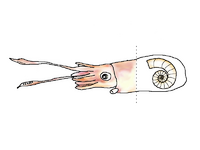Hi Leelan, nice to see this old thread has resurected. I started some time ago a reconstruction of an ammonite, which I wanted to sculpt directly on a cast of an original shell. When it is finished (anytime...) it will become part of the exhibition at the paleontological museum at Tübingen, Germany. I had a lot of discussions about the reconstruction of nautiloids, and I tried to get some more useful information. I came to several conclusions, which could possibly help you. Stupidly there are no soft body impressions which would tell us how living nautiloids really looked like, but still there are some few things we can conclude from this abscence. Even in deposits in which perfect belemnite fossils with fossilised hooks and ink sacs were found, ammonites show nothing. So we can for example conclude they had next to sure no chitinous hooks on their arms. It seems even not that probable they had large suckers too, as they would have fossilized at least sometimes. There are a lot of indications for planctivory in nautiloids, so it´s well possible they had neither very strong and big tentacles, nor big and partly chitinous suckers. As the multiple tentacles in Nautilus are only a secondary development which form during embryogenesis when the ten original tentacles split into many small tentacles, it´s seems more probable that the most primitive cephalopods which were ancestral to Nautilus and nautiloids had ten tentacles, and perhaps ammonites and othrer nautiloids conserved this original bauplan as next to all other cephalopods did too.
When I sculpt my ammonites, I will use Spirula as a reference, as it seems to have a lot in common with early ammonites. Instead of big suckers (like those of many modern cephalopods) or sticky and grooved tentacles as those of Nautilus, I will give my ammonites multiple small sucker pads as those of Spirula. They would be useful for a planctivore and would also most probably be too fragile to fossilize. I would connect the arms at their base at least partly with some skin, and would completely renounce a hood, despite the fact that I sculpted this on my earlier versions. All in all, I would make the whole ammonite comparably similar to Spirula, but of course with some changes, for example to fit the shape of the shell´s opening. I would also make proportionally smaller eyes I think. Spirula is small, but a planctivorous dish-sized ammonite probably didn´t really need bigger eyes.
 Do I really want to chop off 33% of what I have now? 10 inches down to 7?
Do I really want to chop off 33% of what I have now? 10 inches down to 7?


